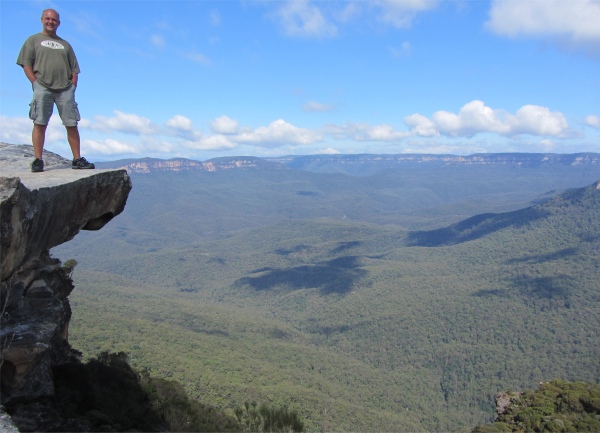
Close to Insanity
|
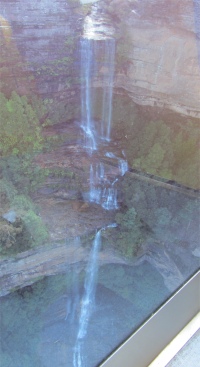
Poor Quality Photo of Katoomba Falls
|
An early start to the day with blue skies to greet me. By 07:30 I was on an Oztrails bus, destination the Blue Mountains. Our driver and guide for the day was Mick,
Around 50km west of Sydney the foothills of the Blue Mountains begin. Sandwiched between the Nepean and Coxs rivers, the Blue Mountains are primarily a sandstone plateau dissected by deep gorges. The region is densely populated by oil bearing Eucalyptus trees. The atmosphere is filled with finely dispersed droplets of oil, which, combined with dust particles and water vapour, scatter short-wave length rays of light, which are predominantly blue in colour. The mountains occupy 10,000 square kms, and include seven national parks and the Greater Blue Mountains Area World Heritage Site.
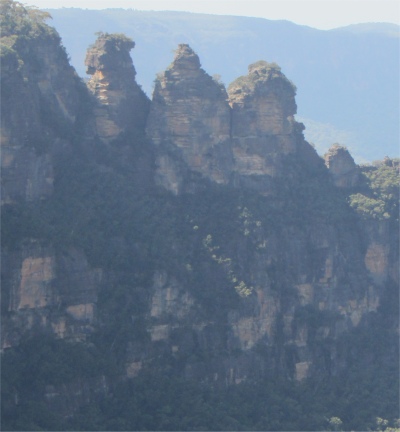
The Three Sisters
|
The Blue Mountains had already been inhabited for several millennia by the Gundungurra people before Europeans arrived in Australia. This group is now represented by the Gundungurra Tribal Council Aboriginal Corporation based in Katoomba. Many examples of Aboriginal habitation can be found all over the region. Walls containing hand stencils from adults and children can be found in Red Hands Cave, a rock shelter near Glenbrook. A rocky knoll at Wentworth Falls has a large number of axe-grinding grooves created by rubbing stone implements on the volcanic rock to shape and sharpen them.

Sulphur Crested Cockatoo
|
It was at Castle Hill in 1779 where Gidley King established a prison town for political prisoners from Ireland and Scotland. The Blue Mountains represented an "insurmountable" barrier that would deter convicts from trying to escape in that direction. Between 1798 and 1813, many people explored various parts of the mountains, from the Bilpin Ridge to the southern regions, today the site of the Kanangra-Boyd National Park. Still, they did not find a definite route across the mountains. In 1813, official credit for crossing the Blue Mountains was eventually given to Gregory Blaxland, William Lawson and William Charles Wentworth. Governor Macquarie sent the surveyor George Evans on an expedition to confirm the discoveries made by Blaxland and his party. By 1815, 30 convict labourers and 8 guards completed a 160km road across the mountains after 27 weeks of hard work. Mick pointed out that the road we were travelling on was the same road blazed by the convicts, though it is covered in asphalt of course. Today, the road is a series of roadworks as a road improvement program is in operation. About 1,000 men with modern machinery are going to spend 5 years improving the road; a far cry from 30 men building it over 7 months.
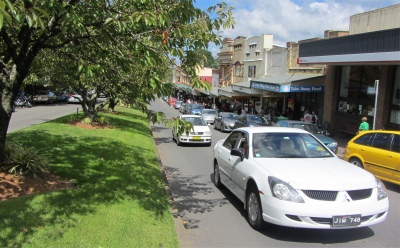
Leura
|
The predominant natural vegetation of the higher ridges is eucalyptus forest, and heath-like vegetation is present on plateau edges above cliffs. The sheltered gorges often contain temperate rainforests. There are also many hanging swamps with button grass reeds and thick, deep black soil.
Wollemia nobilis, the Wollemi pine, one of the world's oldest and rarest plants and a relic of earlier vegetation of Gondwana, is found in remote and isolated valleys of the Wollemi National Park. The land here is subject to bushfires and severe storms. In recent years the lower mountains have been subjected to a series of bushfires which have caused great loss of property but relatively little loss of life.

A Splendid Idea in Leura
|
After a brief stop by the Nepean River, the western boundary of Greater Sydney, we drove up a long ridge on the original road into the Blue Mountains. Our first port of call was Kings Tableland. Here, an outcrop of sandstone, the dominant rock in these mountains, led to a 100m cliff plunge down into the forest in the Jamison Valley.
The view afforded was spectacular, and I could see why the whole area is called the Blue Mountains; everything I saw stretching out into the distance had a blue hue to it, due to the Eucalyptus oil droplets as explained earlier.
Sadly, clowns in the past had stolen cars and brought them up here in order to launch them off the cliff edge into the abyss below. Rusting metallic carcasses lay far below like crushed beetles. Authorities have long since erected steel posts in the access road to stop vehicles being driven up to the outcrop.
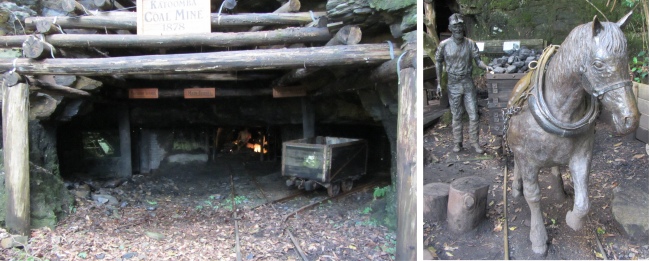
Katoomba Mine Entrance
|
Close to the rocks was a small bed of ochre. Mick scraped a layer of this and mixed it with water to produce a red paste, which he applied to the back of his hand. This was exactly what Aborigines did when they wanted to decorate their bodies.
Having enjoyed this isolated location with the superb spectacle of the Jamison Valley all to ourselves, we headed off to Scenic World and its brutal, unadulterated tourism for the masses. Scenic World is based in the middle of three natural attractions: Katoomba Falls, the Three Sisters rock formation, and the Orphan Rock.
We crossed the deep chasm above the falls via a Skyway: a cable car suspended over a cleft in the earth. During the crossing, I managed to catch glimpses through the mass of bodies, with twitching cameras glued to their heads, of the falls far below me, and the Orphan Rock, a large solitary monolith of sandstone that had once allowed tourists to clamber to its summit via steps and ropes, but had since rendered itself unsafe. Once we reached the other side, I got a better profile view of the Three Sisters.

Sculpture in Jamison Valley
|
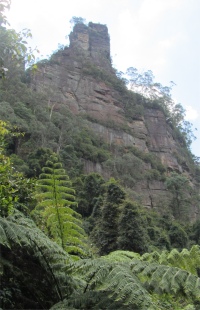
Orphan Rock
|
The Three Sisters is the Blue Mountains' most spectacular landmark. Located at Echo Point Katoomba, around 2.5km from the Great Western Highway. The Sisters are an appreciable landmark, standing at 922, 918 & 906 metres tall, respectively. The changing sunlight on the Three Sisters alters the magnificent colours throughout the day and seasons, bringing out an ever changing character. The Three Sisters is also floodlit until around 11pm each evening, looking simply spectacular set against the black background of the night sky.
The Three Sisters is essentially an unusual rock formation representing three sisters who according to Aboriginal dream-time legend were turned to stone. Life is never simple; there are two legends. According to one legend, Meehni, Wimlah and Gunnedoo were members of the Katoomba tribe living in the Jamison Valley. These beautiful young women fell in love with three brothers from the Nepean tribe, but tribal law forbade them to marry. Of course the brothers were not happy to accept this law, and so decided to use force to capture the three sisters, bringing about a major tribal battle in the process. With the lives of the three sisters seriously in danger, a witchdoctor from the tribe took it upon himself to turn the three sisters into stone to protect them from any harm. While he had intended to reverse the spell when the battle was over, the witchdoctor himself was killed. As only he could reverse the spell to return the ladies to their former beauty, the sisters remain in their magnificent rock formation as a reminder of this battle for generations to come.

Funnel Web Spider Lair
|
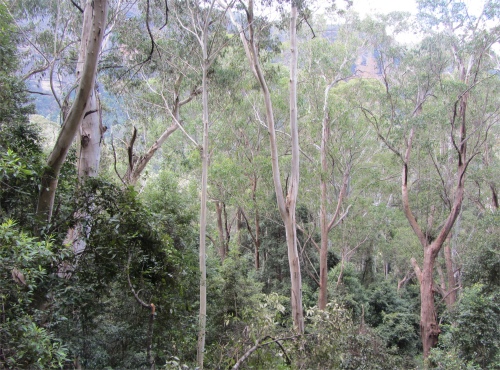
Stand of Eucalyptus Trees
|
The alternative legend goes something like this.... The three sisters had a father who was a witch doctor named Tyawan. Now long ago a Bunyip, who was feared by all, lived in a deep hole in the area. Passing the hole was considered very dangerous, therefore whenever Tyawan had to pass the hole in search for food, he would leave his daughters safely on the cliff behind a rocky wall. One fateful day, Tyawan waved goodbye to his daughters and descended down the cliff steps into the valley. Meanwhile at the top of the cliff, Meenhi was frightened by a large centipede which suddenly appeared before her. Meenhi took a stone and threw it at the centipede. The stone continued on its journey and rolled over the cliff, crashing into the valley below, which angered the Bunyip. The rocky wall behind the sisters then began to split open and they were left stranded on a thin ledge at the top of the cliff. All the birds, animals and fairies stopped still as the Bunyip emerged to see the terrified girls. As the Bunyip began to approach the girls, to protect them from harm, their father used his magic bone to turn them into stone. Angered by this, the Bunyip then began to chase Tyawan. Becoming trapped, in order to flee from the Bunyip, Tyawan changed into a magnificent Lyre Bird, but in the process dropped his magic bone. Tyawan and his three daughters were now safe from the Bunyip. Once the Bunyip had disappeared, Tyawan returned in search of his magic bone, yet this was never to be found. The Lyre Bird has been searching for this magic bone ever since. Remaining in rock formation, The Three Sisters stand silently overlooking the valley hoping that one day he'll find the bone and turn them back to former selves. Rumour has it that when visiting the Three Sisters, if you listen carefully you may be able to hear the Lyre Bird, Tyawan, as he continues his quest for his lost magic bone. Hmmm....., I'm still listening.

Wentworth Falls
|
Once the chasm had been crossed, we were now able to descend into the Jamison Valley via the steepest inclined railway in the world, with a gradient of 51�. The route down was through a natural fissure in the cliff face. This split in the rock had been exploited in another life when the Katoomba coal mine lay at the base of the cliffs, and the miners had used the incline to bring coal up to the plateau, the complete opposite to
Denniston where coal was lowered down an incline.
On the valley floor, a series of boardwalks guided people around nature walks and a sculpture park, all in the depths of the rain forest.

Aboriginal Site
|
Once back out of the valley, it was a quick lunch at Leura, a pretty "Garden Village", and then off to Wentworth Falls. Now all this seems to be slick and well organised, but as events turned out it was anything but. Once our party had been given free rein to grab some lunch, or do our own things at Scenic World, even when Mick had made it abundantly clear where and when to meet up again, we would lose folk. Trying to find two small Japanese girls in a souvenir store full of small Japanese girls, all wearing similar clothing, is nigh on impossible. We kept losing time as more people failed to stick to the time schedules. The biggest hiccup was when the inclined railway stopped working just as we arrived to use it, creating an enormous backlog of tourists while it was being fixed. Mick had to think on his feet to find a work around for that one.
Anyway, back to Wentworth Falls. When we arrived, Mick explained that to see the falls properly, we would have to walk down 280 steps and then walk back up them, and we would have to be brisk. This concept was alien to some folks, who just stayed on the bus. The rest of us proceeded to fly down the steps. Mick had already primed us, as he drove along, about the wildlife around this locality, focussing on poisonous snakes and spiders. He listed the lethal snakes to be found in the area, some of which had been spotted recently, and what to do if a snake is encountered.
As we shot down the steps, Mick pointed out various plants, shrubs and trees, such as the lemon tea tree and herbal plants that Aborigines use in cooking. When we held Eucalyptus leaves up to the light, they appeared to be peppered with myriads of tiny holes. These weren't holes but actually sacs containing the oils. It was only when the leaves were broken or crushed that the oils were released.
As we proceeded down through the bush, Mick was looking up to the vegetation, while the rest of us were scanning the ground for Copperhead snakes. We encountered no snakes, but Mick did point out to us the funnel belonging to a Funnel Web Spider. He agitated the entrance to the lair with a small twig, trying to emulate an insect trapped in the web, but Boris the spider wasn't playing ball today.

Rocks at Entrance to Darling Harbour
|
At the base of the track we had a splendid view across to the Wentworth Falls, a picturesque waterfall on the edge of the Jamison Valley. It plunged almost 300m over two stages; quite spectacular.
Time was running out - our backstop was a cruise boat picking us up to deliver us back to Circular Quay, and it wouldn't wait. "We have two more items left on our agenda: visit an Aboriginal site and try and spot kangaroos in a part of the bush, though since it is still warm, there is only a slim chance we might spot a kangaroo. Those animals have no sweat glands, so during high temperatures, they tend to dig a hole, lie in it and cover themselves in earth to keep the sun off. Sadly we have lost time and we can only commit to one. So, let's have a democratic process here. Hands up those who want to see the Aboriginal site," said Mick, hoping for vociferous debate on the matter. I and a German lad put our hands up. We were outnumbered 10:1 so the outcome was going to be obvious. However, to carry on the democratic process and make doubly sure, he piped up, "OK, hands up for kangaroo spotting." No hands were raised, apathy ruled. So, off we went to the Aboriginal site.
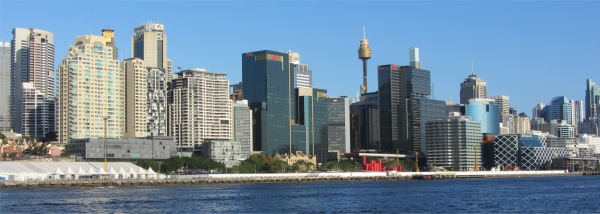
And Alongside the Rocks, the Modern Counterpart
|
At the preserved site, a kangaroo had been carved into a table sized horizontal slab of sandstone, with a boomerang carved just below it. Mick poured water into the manmade grooves to highlight the carving. "You must never scrape material out of the grooves, only the Aboriginal elders can do that, and even then it has to be accompanied by a large ceremony," explained Mick.
He went on to explain that Aborigines didn't always use boomerangs that came back. If one arm was made longer than the other, it would travel in a straight line. This type of boomerang was often used to disable kangaroos, which were tough creatures at the best of times. Once a creature was disabled, the hunters would move in for the kill with spears, and indeed this carving did show a spear running through the kangaroo. For some reason, at this point the song "My boomerang won't come back" entered my head, and I couldn't shift it. I think it was Charlie Drake who used to sing that.
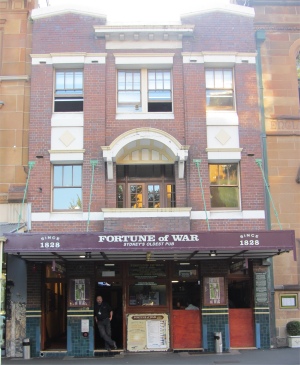
Fortune of War
Australia's Oldest Pub
|
A very important feature of such carvings is that they were used as navigational waypoints. The tail of a creature would point to where the tribe had just travelled from, and usually there would be another way point some kilometres away in that direction pointing to this one, and the head would point to the direction they were next headed.
Aborigines would describe the routes they would take, the landscapes they passed through, and also the waypoints in the form of "singing lines", where the lyrics would provide all the description needed.
We sped back towards Sydney, making a brief detour through the 2000 Olympic Park complex, and down to a wharf near the park where our boat was waiting for us. It was a quick farewell to Mick, and we all piled onto our vessel.
We made our way down the Parramatta River, past more expensive looking suburbs, and eventually entered the Sydney Harbour where we bobbed under the Coathanger before berthing at Circular Quay.
It had been an excellent day up in the Blue Mountains, enhanced by Mick's non-stop banter, humour and his attempts to teach us Australian slang. In a conversation I had with him alone, he told me about his plans to set up his own company in the next couple of months. The Blue Mountains are already saturated with tour companies, but he saw a market for exploring the area 3 hours south of Sydney on the coast. Here hundreds of Aboriginal sites existed, and he had spent a long time cultivating Aboriginal contacts who would act as guides around these sites. In addition, there was much to be seen in the area regarding sea life. I wished him the best of luck on that one.
Back at Circular Quay, I walked to the Rocks and enjoyed a cool beer in the oldest pub in Australia, the Fortune of War, and sat back and reflected on my day.

